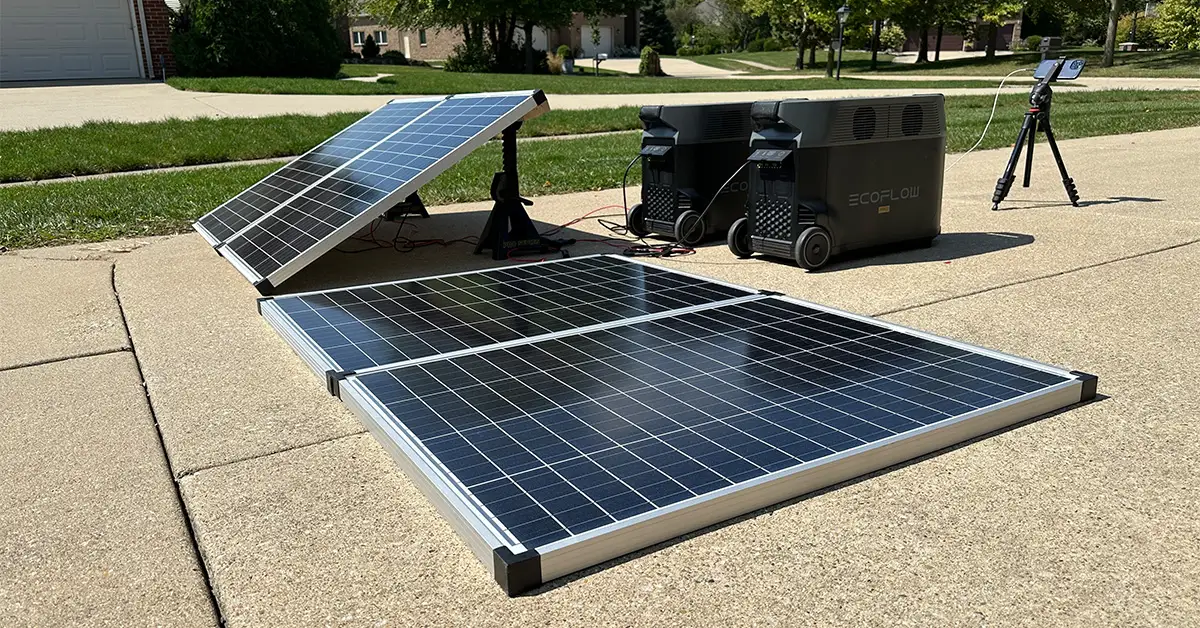There’s a crucial factor in solar energy that often gets overlooked: the solar panel tilt angle.
Maybe you’re considering solar panels for a flat pergola, and you want to know how significant the power loss will be if you mount them flat. Should you go for the cheaper flat mount, or is it worth the additional cost to give your panels a bit of an angle?
In this article, I’ll guide you through a real-world test of mounting panels flat versus at an angle and how it impacts power output.
But first, I’ll share some insights on finding the best solar panel angle for your specific location. So, let’s get started.
Rather watch than read? Check out this 7-minute video.
Understanding Solar Panel Tilt Angle
Before we dive in, let’s understand why panel angle matters.
The solar panel angle, or tilt, is crucial for optimizing the efficiency of your solar power system. It’s all about getting your panels to catch as much sunlight as possible throughout the day and across the seasons.
By adjusting the tilt, you can grab more sunlight in the winter when the sun hangs lower, and dial it back a bit in the summer when it’s higher up. This boosts efficiency and also makes your solar system more cost-effective.
The Best Panel Angle: Location Matters
To find the best panel angle for your setup, I recommend using a solar panel mounting angle calculator.
This calculator from Footprint Hero is simple and straightforward to use. Just input your address, and it provides an optimal year-round average angle for your specific location.
Seasonal Considerations for Solar Panel Angles
The calculator will also break down your optimal tilt angle by months and seasons.
For example, in Chicago it shows that the optimal angle varies from 17.3 degrees in summer to 47.3 degrees in winter—which is quite the difference!
Understanding these fluctuations can be very helpful, especially if you’re planning a ground-mounted system and need to decide on a fixed angle or an adjustable setup for the changing seasons.
How to Find Your Roof’s Degree Angle
If you’re considering a professionally installed, grid-tied system on your roof, determine your roof’s degree angle using the measurement app on your mobile device.

On your Apple or Android phone, use the measurement app with the built-in bubble level feature. Lay the phone on your roof’s surface and it will give you the slope in degrees.
If you need to cross reference, check out the roof pitch to degrees conversion chart below:

In my case, with a 29-degree roof angle, it corresponds close to a 7/12 roof pitch.
Real-World Test: Flat vs. Angled Solar Panels
Recently, I conducted a test using 100-watt Thunderbolt panels from Harbor Freight. The flat panels were mounted in series, while the angled ones matched my roof pitch at 29 degrees.
The goal was to measure the power output difference between the two setups, helping me decide whether the added cost of angling the panels is worth the investment.

Test Setup
- Flat Panels: 2 x 100W Thunderbolt panels wired in series.
- Angled Panels: Also 2 x 100W panels, angled at 29 degrees to match my roof.
- Measurement Tools: RC power analyzers to track voltage, amperage, and energy output.
- Portable Power Station: Each solar panel setup is connected to a Delta EcoFlow Pro, which will store the energy generated.
Test Conditions
I conducted a two-hour test during excellent sunlight conditions with occasional clouds between 1 PM and 3 PM.
Also worth mentioning, this test was in September, with the angled panels set at the ideal angle for my area.
Results
Now, let’s take a look at the test results from my power analyzers:
- Angled Panels: 388 Watt hours
- Flat Panels: 313 Watt hours

Comparing the two results, there was a 19.4% decrease in power output from the flat panels. That’s a substantial difference!
This power loss could be a game-changer when determining your solar panel setup. If you’re debating between flat or angled solar panels, the angled setup is probably worth the extra investment.
Considerations for Your Solar System
As you continue to explore solar energy, consider these additional factors for an efficient and cost-effective system:
- System Size: Determine the size of your system based on your current and future needs, including potential additions like electric vehicles.
- Cost Estimates: Solar Reviews can estimate the size and cost of your system. This tool can connect you with multiple local installers for more refined bids.
- Wire Gauge: The gauge of your wire can be critical. Check out our article on wire gauge testing to understand how selecting the right gauge can prevent power loss in your system.
Conclusion: Angling for Optimal Solar Power
Let’s wrap things up with our main takeaways:
- Location-specific Optimization: Use a solar panel mounting angle calculator to determine the ideal angle based on your location, taking into account latitude and seasonal changes.
- Seasonal Considerations: Understanding the seasonal variations in optimal panel angles is crucial for maximizing efficiency throughout the year.
- Real-world Test Results: In my two-hour test, angled panels outperformed flat panels by 19.4%, showcasing the tangible impact of the right angle on energy production.
- Cost vs. Benefit: While angled setups may incur additional costs for mounting hardware, the long-term gains in energy production often outweigh the initial investment.
- System Planning Tips: Consider your system size, cost estimates, roof angle, and wire gauge when planning a solar setup tailored to your home’s unique needs.
Remember, the angle of your solar panels isn’t just a technical detail—it’s a key factor in harnessing the power of the sun. So, angle right, and let your energy savings soar!

